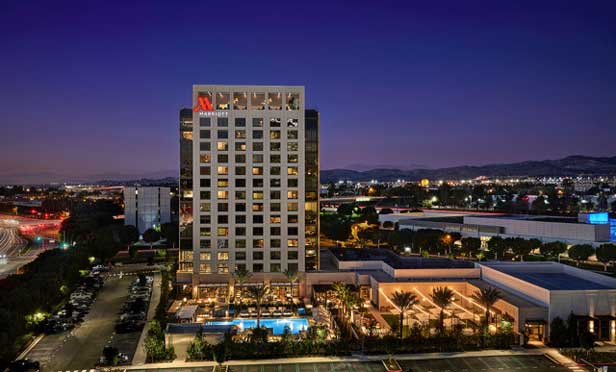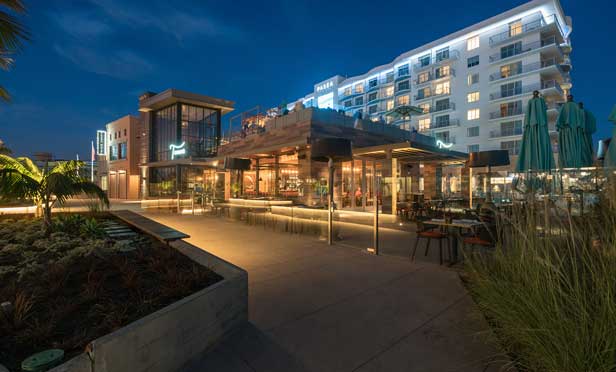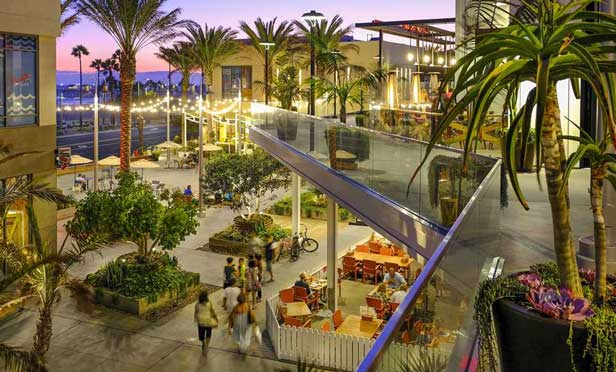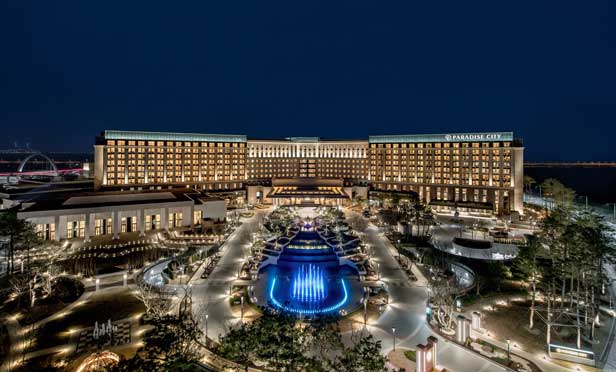 R.D. Olson Construction recently completed construction on the Irvine Spectrum Marriott, a $120-million full-service hotel. The 15-story property helps to fill a void for high-end product in the market.
R.D. Olson Construction recently completed construction on the Irvine Spectrum Marriott, a $120-million full-service hotel. The 15-story property helps to fill a void for high-end product in the market.
Last year New York City-based MCR, the seventh largest hotel owner-operator in the US, acquired two Marriott hotels in Lehi, Utah, a suburb of Salt Lake City. The properties, which traded for $27.5 million, are located in Salt Lake City's Silicon Slopes technology corridor—a key allure to MCR.
MCR has a $2-billion portfolio of 104 hotels with more than 12,000 rooms in 27 states and is known in its home town for co-owning the High Line Hotel in Chelsea with the Brodsky Organization.
But lately the company, which just closed a $300 million fund with $1 billion in purchasing capacity, has not been focusing on gateway markets. Rather, it has been concentrating on secondary markets, such as Salt Lake City, Providence and Milwaukee. “We are not making big bets on macro concepts like inbound tourism, Chinese visas, the strength of the dollar versus the euro or anything like that,” says Russ Shattan, senior vice president of acquisitions & development at MCR. “We're making bets on limited service and suburban hotels. The demand generators are within four to five miles of each of our properties.”
As an example, MCR has acquired hotels in Champaign, IL, across the street from the University of Illinois, which has a student population of 50,000. And those hotels in Lehi? Lodging demand for the area, which has a concentration of tech companies including a large Adobe campus, is mostly business travel or visitors to headquarter locations.
“We are insulated from the transient tourism trends,” says Shattan. “That's why we like investing in those hotels. We think it's a safer, better investment. It's a steadier investment.”
MCR is, like most of the US hotel companies, carving out a strategy to stay ahead of the asset class' market cycle—a cycle that is currently booming. Its focus on secondary markets is also reflective of a trend that began in 2017, one in which more hotels are selling outside of the top 25 markets than in these markets. In short, there has been a shift from downtown urban hotel transactions to the suburban hotel sales, the according to the Hotel Transaction Almanac 2018, released by STR in conjunction with Hotel Brokers International (HBI) earlier this year.
The move by investors to suburban locations had one unfortunate effect: a 12% drop in investment price per room in 2017, according to the report, with the average total investment per room declining more than $30,000 to $240,000 from the record average established in 2016 of $272,000.
Yet that should not deflect from the US hotel industry's overall strong performance. The US hotel industry is projected to continue posting record-breaking performance levels through 2019, according to STR and Tourism Economics' recently released revised forecast released. For 2018, the US hotel industry is projected to report a 0.4% increase in occupancy to 66.2%, a 2.5% rise in average daily rate (ADR) to $129.74 and a 2.9% lift in revenue per available room (RevPAR) to $85.89. RevPAR grew at least 3% for each year from 2010 to 2017.
“Solid economic indicators and a room construction total that represents just 3.6% of existing supply certainly help marketplace conditions as well,” says Amanda Hite, STR's president and CEO.
Other figures underlining the hotel sector's strong fundamentals come from preliminary data by JLL. The firm's researchers found that for the first four months of this year, the volume of investment sales transactions for US hotels rose 93% over the same period last year, reaching more than $11.9 billion.
 Located in Huntington Beach, CA, the mixed-use complex includes the luxury oceanfront Pasea Hotel & Spa.
Located in Huntington Beach, CA, the mixed-use complex includes the luxury oceanfront Pasea Hotel & Spa.THE RISKS IN THE LANDSCAPE
Would that the lodging story was able to end on that note. But even during strong asset class cycles, risks are always part of the landscape—especially as investors continue to move beyond the gateway markets and top-tier assets.
High-quality, full-service lodging properties present relatively high cash flow volatility and are more sensitive to labor policy changes and unexpected factors such as extreme weather and natural disasters than other product types, according to Mitch Paskover, president of Continental Partners. As such, “lenders remain conservative in their underwriting and are carefully scrutinizing opportunities.”
Already lenders are lowering leverage to 70% to 75% on full-service hotels, and 65% to 70% for limited-service hotels, he notes. “If the current trends continue, we anticipate that lenders will mitigate risks through lowering leverage further.”
Meanwhile, borrowers are now busy trying locking in interest rates before they rise in order to refinance and pay off existing loans. In some cases, Paskover adds, “they're looking for opportunities to secure large loans that provide additional resources to stabilize any volatility from associated risks.” This includes implementing new amenities and value-add renovations to ensure steady occupancy rates and position their assets to compete with disruptors.
Airbnb, in particular, continues to be one of those disruptors. Some owners “are worried it will decrease demand for traditional hotels,” he explains. The good news, Paskover points out, is “there's no sign that it will create a negative impact for full-service, high-quality hotels, which offer amenities that most Airbnb locations simply cannot match. That said, with so much opportunity for growth remaining for Airbnb, it could pose a threat to the limited-service, budget hotels.”
There are other models on the horizon that could further disrupt the lodging industry. Washington, DC-based startup WhyHotel has launched a pop-up hotel model in which temporary hotels open in newly delivered luxury apartment buildings. WhyHotel uses the units that have not yet been leased up as temporary hotel rooms, adding a service that turns the building into a temporary, 24/7 onsite staffed hotel.
 Approximately 40% of the acreage at Pacific City is dedicated to its landscape environment, including sustainable wooden benches, fire pits and umbrella-covered patios.
Approximately 40% of the acreage at Pacific City is dedicated to its landscape environment, including sustainable wooden benches, fire pits and umbrella-covered patios.HOW BRANDS CAN STAND OUT
Owners and operators, to state the obvious, are well aware of the competitive environment with both its high demand and ever-present risks. As they navigate this landscape they are using multiple strategies to remain ahead of the game. Some are in the market for financing to add new amenities or make value-add renovations to ensure steady occupancy rates and limit the impact of the disruptors, according to Paskover.
Indeed, STR also notes that there was a big increase in capital expenditures right after the sales transaction. “That shows you that a lot of the hotels that were sold were purchased with the idea of undergoing a major renovation,” according to Joseph Rael, STR's director of financial performance. Specifically, the amount of additional capital infused into hotels following acquisition rose significantly to $37,000. This was the highest level of additional capital per room since 2012 and the second highest since 2000.
“For new developments, investors must stay on the pulse of energy-saving trends and technologies in order to implement property features, ranging from shower heads to HVAC systems, that will contribute to long-term efficiency and compliance,” relates Holly Neber, CEO of AEI Consultants.
But beyond the tried-and-true strategies of renovations or adding new amenities, some hotels are pushing beyond the typical.
Dual-branding is an emerging trend that can deliver higher revenues to hotels, says Bill Wilhelm, president of R.D. Olson Construction. “With dual brands, you have economy of scale by reducing both back and front of house staffing needs and improving efficiency. Guests benefit from having access to options and amenities that might not be available at a single-branded property.”
Also dual brands offer hotels higher occupancy rates for that one location, John David Booty, EVP at Ventus Group, says. It also, he adds, “reduces the risk of competition from nearby locations, while improving operating costs due to shared lobbies, back-of-house and/or amenities.”
Another way hotel developers are standing out is by incorporating public amenities into projects, Wilhelm says. “A guest room is a guest room and you're not going to change that since each brand has its own requirements and restrictions.” But the public space on the property and the surrounding amenities in the community are where developers can get really creative, he says. “Whether it's a pool, fire pit, shuffleboard, dining/entertainment, Wifi, communal areas, coffee shop or lounge area, the possibilities for amenities are truly endless.”
Lodging is all about the guest experience, says Julie Brinkerhoff-Jacobs, president and chief financial officer of Lifescapes International. “Guests want to feel 'transported' from the moment they arrive at a hotel and continue through their entire stay.”
One way owners are achieving this is by working with design partners to create 'mini destinations within destinations' throughout their resort to increase the sense of discovery for the guest. Brinkerhoff-Jacobs points to Pacific City, which includes the four-star luxury oceanfront hotel, Pasea Hotel & Spa in Huntington Beach, CA, as an example of this 'mini destination' strategy. Approximately 40% of Pacific City's acreage is dedicated to its landscape environment.
 The latest lodging trends aren't only seen in properties stateside. The Paradise City development in Incheon, South Korea, demonstrates the significance landscape design and 'mini-destinations' play in contributing to the success of mixed-use projects.
The latest lodging trends aren't only seen in properties stateside. The Paradise City development in Incheon, South Korea, demonstrates the significance landscape design and 'mini-destinations' play in contributing to the success of mixed-use projects.This strategy, it should be noted, translates well in international markets. Brinkerhoff-Jacobs also tells of a resort in South Korea called Paradise City which consists of hospitality, gaming, an art gallery, retail amenities and restaurants. There are also wedding gardens that infuse the project with multiple vibrant landscape mini destinations that deliver a Las Vegas flair that attracts guests from across the world year-round.
The goal was to combine these elements found in Las Vegas resorts with “hallyu” or Korean pop culture. “The successful combination of these features,” points out Brinkerhoff-Jacobs, “is evident in the fact that Paradise City is one of the busiest integrated resorts in South Korea.”
SIDEBAR
How Can Hotels Cope When Tourism Recedes?
Ventus Group is currently at work on a mixed-use development featuring a 298-key hotel in Los Angeles that is close to several tourist destinations. The project, which includes retail, multifamily, student housing and creative office space, also happens to be next to the University of Southern California campus. Thus, if tourism slows, according to John David Booty, EVP at Ventus Group, another demand driver will help sustain the project—namely, the visiting families of students, alumni and prospective students.
Given the recent trends in tourism flows, Ventus Group and other hotels such as MCR with its acquisition of two Marriott hotels in Utah, are doing well to take into account alternative demand drivers.
Travel and tourism is an $8-trillion market, approximately 10% of the world's GDP, and it's expected to increase by 44% in the next decade, according to comments made by Jonathan Tisch. The chairman and CEO of Loews Hotels & Co. spoke at the 40th Annual NYU International Hospitality Industry Investment Conference, held recently in New York City.
But he warned, “Even though the global travel market is growing, the US share of the market fell nearly 13% over the past few years. That means we missed out on 7.4 million international visitors, $32 billion in lost spending at American destinations and businesses and 100,000 additional jobs.”
Tisch pointed to Visit US Coalition data that by contrast indicated other countries including China, Germany, Australia, the UK and Canada are experiencing a rise in tourism. He said many leaders in the hotel and tourism business believe America currently is giving off an unwelcoming message. As one example, he cited President Donald Trump's policy of “extreme vetting.”
“If people don't feel welcome, they won't visit the US,” he warned. “They won't shop in our stores, eat in our restaurants, stay at our hotels and vacation at our destinations.”
He offered some solutions for hoteliers that could help reverse this tide. First, the industry needs well-planned, proactive marketing. With intense global competition for travelers, Tisch said he continues to support Brand USA, a public-private marketing organization focused on increasing international visitors to come to the US that was created by the 2009 Travel and Promotion Act. Funded by the international travelers and not taxpayers, last year it bought one million visitors and generated $8.5 billion for the US economy, according to Tisch. But he added the Trump administration has proposed its elimination, prompting Tisch to emphasize that the industry must diligently protect its interests.
Second, stay on top of security concerns but with smart policies that are effective and efficient. Tisch stated that under new policies, extreme vetting would apply to 14 million visa applicants. As an alternative, he supports an international travel security program which would require countries to share intelligence on suspected terrorists and criminals, upgrade security standards to a uniform level, and adopt e-passports which make forgery more difficult. In addition, advancements in technology, such as facial recognition software and 3-D baggage scanners, would make traveling safer.
Third, upgrade infrastructure, including airports, roads and bridges. Tisch noted smart road technology that assists in managing traffic is being rolled out in several states. He referenced President Trump's call for massive spending to upgrade the country's infrastructure and agreed that this would be necessary to support growing travel and tourism.
Finally, Tisch pointed to overcrowding beyond airports and roads and at the travel destinations themselves. As examples, he pointed to Venice, where the local population has dwindled to half its size as tourism grows in popularity. He also described how in the US, national parks are beginning to feel the brunt of too many visitors.
Tisch suggested that industry professionals market less congested, off-the-beaten path destinations. They can identify areas which need more infrastructure to accommodate the influx of tourists. Tisch also recommended that industry professionals work with communities to preserve historic and cultural areas.
“As an industry, we are uniquely positioned to help solve these challenges while growing the US share of the international travel market,” Tisch stressed. “The future is ours to win. But we must compete. We must invest. And we must innovate.”—Natalie Dolce and Betsy Kim
© Touchpoint Markets, All Rights Reserved. Request academic re-use from www.copyright.com. All other uses, submit a request to [email protected]. For more inforrmation visit Asset & Logo Licensing.







